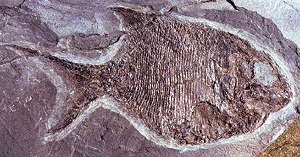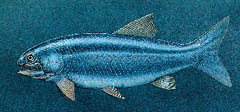

| Actinopterygii | ||
| The Vertebrates | Actinopterygii |
| Vertebrates Home | Vertebrate | Vertebrate |
|
Abbreviated Dendrogram
Gnathostomata
├─Placodermi
└─○Eugnathostomata
├─Chondrichthyes
└─Teleostomi
╞═Acanthodii
└─Osteichthyes
├─Actinopterygii
│ ├─Cladistia
│ └─Actinopteri
│ ├─Chondrostei
│ │ ├─Birgeriidae
│ │ └─Acipenseriformes
│ ├─Saurichthyidae
│ └─Neopterygii
└─Sarcopterygii
|
Contents
|
The Chondrostei are cartilagenous fish, but not sharks. They are early actinopterygians, definitively known from the Early Triassic. Persistent reports of much earlier (Mississippian) chondrostian-like parasphenoids (e.g., Štamberg & Zajíc, 2000), and similar odd pieces may eventually push this date back considerably.Since the Chondrostei have few bones, it is not surprising that the fossil record is unreliable. There are 25 extant species, including 23 sturgeon species and two species of paddlefish. All extant chondrosteans spawn in rivers with moderate flow and hard beds, but -- with rare exceptions -- spend their adult lives outside the spawning area. Sillman et al. 2005).
The Chondrostei have been through a number of cycles of classification. They were originally classified with the sharks. This is not as unreasonable as might seem. Recent chondrosteans share a number of features with recent chondrichthyans, including the (not quite!) absence of endochondral bone, a peculiar type of jaw suspension with a protrusible palatoquadrate, a pronounced rostrum, an antero-ventrally oriented mouth, minimal squamation, and a tendency to be really big predators near the top of the local food chain. By the mid-nineteenth century, however, it became clear that this sort of scheme wasn't going to work well for fossil forms, such as Chondrosteus which was first described in 1844.
The taxon then became the flagship of a new classification scheme based on degrees of ossification, in which the Chondrostei were believed to be the most primitive of osteichthyans. Although the classification scheme did not last, the "primitive" label stuck. By the mid-twentieth century, the Chondrostei had become a garbage taxon full of "paleonisciform" fish of uncertain affinities.
Largely due to the efforts of Prof. William Bemis of the University of Massachusetts [a disparaging reference to his aging web page has been deleted as it has finally been updated as of 11/02], Lance Grande of the Field Museum (whose web page is even more out of date), and their students and co-conspirators, the taxon has been stripped -- as it were -- to the bones and given a proper cladistic foundation. Bemis and Grande use the name "Chondrostei" rarely, preferring the less ambiguous "Acipenseriformes." However, there is still some utility in a stem taxon defined as fish more closely related to caviar (Huso) than to lox (Salmo), and it is in that sense that "Chondrostei" is used here. Bemis's most recent scheme is the following:
Phylogeny of Grande & Bemis(1996)
 |
 |
In spite of the long history of confused classification, the evolution of the Chondrostei makes fairly good sense. In the early Mesozoic, a number of fish families were beginning to develop adaptations which would make them lighter, faster and more efficient predators. Generally speaking, these adaptations involved a lighter squamation and specialized jaws allowing the back posterior) of the maxilla and/or premaxilla to swing down and out so that the whole jaw apparatus was shot forward to suck in prey. The chondrosteans branched off fairly early on, probably towards the middle of the Triassic, and consequently tried their hand at these developments without the elaborate structures developed by later, neopterygian groups. That is, for whatever reason see below), they seem to have felt the hand of these selective pressures a bit earlier than some other groups.
Neopterygians gradually developed lighter scales and lighter, acellular types of bone. The chondrosteans simply dropped their heavy scales, almost completely, and omitted ossification of cartilage altogether. Elderly individual chondrosteans still develop centers of endochondral ossification, so we may suppose that that ossification of cartilage was simply slowed down relative to other developmental programs. Neopterygians developed various different, complex mechanisms for allowing the maxillary bones to attach to the palate anteriorly so that they could shoot the jaw bones forward as they opened the jaw. Chondrosteans again took a radical, but conceptually simpler approach. They simply lost the maxillary bones completely. The teeth are attached to the dermopalatines and the entire palatoquadrate essentially drops off the braincase and takes everything else with it, remaining in articulation only through the hyomandibula.
Why did Chondrosteans react so quickly, in evolutionary terms, and with such total reorganization? Undoubtedly there are a number of different answers which apply, but one answer surely has to be the way in which they evolved. Chondrosteans, like only a few other vertebrate groups, have clearly undergone several rounds of polyploidy. Normal vertebrate cells have two of each gene, a maternal set and a paternal set. They are referred to as diploid, i.e. with two of each kind of chromosome (the cellular structures which contain each cell's complement of DNA), or "2n". For a variety of reasons, a cell may occasionally replicate its DNA complement but fail to divide during that cycle. It ends up with four of each gene. Such cells are tetraploid, or "4n". If this occurs during the first steps of development, an entire organism may become 4n and pass the trait on to its progeny. Normally such sports are not viable in the animal kingdom, or are sterile. However, a few types of organisms appear to be able to survive, or even flourish with polyploid genomes. Chondrosteans or one of those types. Indeed, recent chondrosteans are 8n or 16n. Such a dramatic genetic change undoubtedly creates the potential for sudden, drastic reorganization of the body plan.
Thus, it is not surprising that the Chondrostei "reacted" more quickly to the general selective pressures facing Mesozoic fish, and that they reacted by reorganizing their existing structures rather than, as was the case with neopterygians, by gradually evolving new and different structures.
ATW 040806, revised ATW060201.
Image: Peipiaosteus from The Stone Company. Polyodon from the National Marine Fisheries Historic Image Collection.
from the Permian
Actinopterygii:: Cladistia + *: Chondrostei + Saurichthyidae + Neopterygii.
Characters: $ keystone-shaped dermosphenotic [J96]; $ rudimentary posttemporal fossa [J96]; $ lateral cranial canal in braincase [J96]; $ fulcral scales on leading edge of all fins [J96] (strengthens leading edge of fin, preventing collapse & allowing higher swimming speed); paired fins without basal lobes [J96]; strongly reduced axonemal (?!!) fins; swim bladder connecting to foregut.
Links: Untitled Document; abst94c.htm;
Janvier 1996) [J96].
Note: an axoneme is a generic term for both cilia and flagella. What could it possibly mean in this context? APW 040806.
Range: from the Triassic of northern hemisphere.
Phylogeny: Actinopteri: Saurichthyidae + Neopterygii + *. Birgeriidae + Acipenseriformes.
Description: Often very large; reduction and loss (fusion with dermopalatines?) of maxilla and premaxilla; unique, independently derived jaw protrusion mechanism similar to Neoselachii hyomandibula articulates with jaw at hinge, entire structure pushed outward and downward as hyomandibula swings forward -- head not raised); palatoquadrates meet at midline; loss of posterior myodome; many possess spiracle, physostomous swim bladder involved in respiration; $ parasphenoids elongated past occipital condyle (possible as head is not raised in feeding); vertebrae above post occipital extension of parasphenoid at least partially fused (again, possible because head-raising not required); notochord free and extensive; endochondral bone strongly reduced or absent (but additional centers of ossification may appear in advanced age); loss of much dermal skeleton, especially on rostrum and in cheek; $ opercular reduced or absent (dominant bone of opercular series is subopercular) strongly heterocercal tail; $ scales very limited or absent; numerous jointed fin rays; ampullary electroreceptive organ (lost in Neopterygii); chemosensory barbels; may are anadramous; all possess a spiral valve intestine.
 Image: Huso huso (beluga) from Fitzinger, LJ & J Heckel (1836), as stated in Bemis et al. (1997). Lower image, Cheirodopsis (Mississippian of England) from Paleozoic Fish (I'm not at all convinced of the date or identification, but a wonderful site nonetheless!).
Image: Huso huso (beluga) from Fitzinger, LJ & J Heckel (1836), as stated in Bemis et al. (1997). Lower image, Cheirodopsis (Mississippian of England) from Paleozoic Fish (I'm not at all convinced of the date or identification, but a wonderful site nonetheless!).
Introduction to the Chondrostei; bibliography of sturgeons; Comparisons; Chondrostei; Untitled Document; BioMed Central - Normal embryonic stages of the Longnose Gar, Lepisosteus osseus; Infraclass: Chondrostei; Stamberg Zajic 2000.pdf; Chondrostei- Fishes a few good links); Chondrostei nice, short introduction); Knorpelganoiden German: very brief summary); OTHER FISH great images); Untitled Document lecture notes); Morphology of interesting abstract on a possible sister taxon).
References: Bemis et al. (1997); Birstein et al. 1997); Grande & Bemis (1996); Janvier (1996), Sillman et al. (2005) [S+05]; Štamberg & Zajíc, 2000. ATW 060201.
 Birgeriidae:
Birgeria, Ohmdenia, Psilichthys.
Birgeriidae:
Birgeria, Ohmdenia, Psilichthys.
Range: Early Triassic to Early Jurassic.
Relations Chondrostei: Acipenseriformes + *.
Characters: long parasphenoid with elongated posterior "stem"
Image: Birgeria from the Paläontoligisches Istitut & Museum of the University of Zurich.
Links: PMS:Naj... predmeti; Kleiner Museumsrundgang (German); PMS: Kustodiat za paleontologijo (Slovenia?); SyrenCRL; Zajic_2000.pdf; BIRGERIA; Birgeriidae Mikko's Phylogeny); Birgeria sp image only); Museo Scienze Naturali (image); APPENDIX D contains a good paragraph on lifestyle); fische trias muschelkalk fossilien quastenflosser hai zahn detail of fin); Dinosaurclass.Com Chinese).
ATW 040806.
 Acipenseriformes: Acipenser, Polyodon (sturgeons, paddlefish & extinct relatives).
Acipenseriformes: Acipenser, Polyodon (sturgeons, paddlefish & extinct relatives).
from the Early Jurassic.
Chondrostei: Birgeriidae + *.
Links: WIEM: Jesiotrowate (Polish); Fishes of Minnesota - Distribution Table; IWR: Taxa: Acipenseriformes; Acipenseriformes; acipenseriformes Italian -- brief but informative); Acipenseriformes. Spanish); Sturgeon mtDNA sequence results.
Image: Acipenser fulvescens, photograph by Konrad Schmidt, used by permission. APW 040806.
 Saurichthyidae: Saurichthys.
Saurichthyidae: Saurichthys.
Range: Early Triassic to Early Jurassic of Madagascar, Europe, Russia, Greenland, Spitsbergen, North America, & Australia.
Actinopteri: Chondrostei + Neopterygii + *.
Characters: 40-180 cm; long, thin jaws in elongated rostrum; conical teeth; lightly built dermal bones in head; notochord continuous & unrestricted; postzygapophyses absent; later species have greatly elongated (4-6 vertebral lengths) prezygapophyses; basidorsal and interdorsal elements ossified only in caudal region; 4 longitudinal rows of ganoid scales; some sexual morphs known; viscera probably restricted to far anterior with entire posterior devoted to propulsive musculature; wide-ranging predator with broad ecological distribution.
Links: Chondrostei; Swimming patterns; conve.htm; fisch_div_en.html; Kleiner Museumsrundgang (German); Véran.
References: Bemis et al. (1997); Janvier (1996).
Image: Saurichthys from conve.htm.
Note: widely stated to have been a top predator, despite sometimes relatively small size. This observation may be based in part on its very broad ecological range and the fact that it is seldom (never?) found in groups. Based on body shape, it is believed to have been capable of high accelerations and possibly ambush predation. The physiological basis for this conclusion is discussed in detail at Saurichthys. However, ambush predators are more likely to specialize in a particular type of terrain and hence a limited range. Nevertheless, the physical similarity to, e.g. the modern pike (Esox) is striking.
APW 040806.
checked APW 040806.